The Korean War Gallery in the National Museum of the United States Air Force in Dayton, Ohio features of number of airplanes from this war. It was during this war that the use of jet airplanes in combat was refined.
According to the Museum:
The U.S. Air Force was only three years old as a separate service when North Korea invaded South Korea in the summer of 1950. The next three years brought significant changes in technology, roles and tactics, marking the beginning of the modern Air Force.
When World War II ended, the United States accepted the surrender of the Japanese in Korea south of the 38th parallel, while the Soviet Union accepted the Japanese surrender north of that line. Although the western Allies intended that Korea become an independent democracy, the Soviet Union had other plans.
In 1947 the United States put the problem of Korean independence before the United Nations. When the UN ordered free elections throughout the country, the Soviet Union refused to allow them in the north. Free elections in the southern half of Korea in May of 1948 established the Republic of Korea. The Soviets created a rival communist government in the north, the "People's Democratic Republic of Korea."
With governments established in both halves of Korea, the Soviets announced their intention to leave the country and challenged the United States to do the same. After training a small national force for internal security in South Korea, the United States departed, leaving only a few military advisors. In the north, the Soviets oversaw the creation of the well-trained and equipped North Korean People's Army with Soviet tanks, heavy artillery, and aircraft. After assuring the military superiority of North Korea, the Soviets left in 1949. Less than a year later, border skirmishes between north and south exploded into all-out war with the North Korean invasion of South Korea on June 25, 1950.
The United States was committed to defending South Korea against communist aggression. Although the United States had no official treaty obligating it to South Korea, President Harry Truman ordered U.S. forces in the Far East into action on June 27, and three days later authorized air attacks in North Korea. He also began to mobilize reserves for the coming battles.
The Korean crisis was also the first major test for the five-year-old United Nations. On June 25, 1950, the United Nations Security Council met to address the crisis. The Soviet Union, boycotting the UN because the international body did not recognize communist rule in China, did not attend. On June 27, the U.S. proposed the UN intervene in Korea with armed force. With the Soviets absent and unable to veto the measure, the resolution passed. In addition to South Korea and the U.S., 15 other member nations sent military forces to stop the communist attack.
Shown below are some of the Korean War American fighter planes which were on display. (Note: the Soviet MiGs have their own photo diary.)
North American F-86A Sabre
According to the Museum:
The F-86, the U.S. Air Force's first swept-wing jet fighter, made its initial flight in October 1947. The first production model flew in May 1948, and four months later, an F-86A set a new world speed record of 670.9 mph.
As a day fighter, the F-86A (and later F-86Es and F-86Fs) saw service in Korea as the primary opponent of the Russian-built MiG-15. By the end of hostilities, F-86 pilots had shot down 792 MiGs, with a kill ratio of about 8:1.
More than 5,500 F-86 day fighters were built in the U.S. and Canada. Air forces of 20 other nations, including West Germany, Japan, Spain, Great Britain and Australia, also operated the Sabre.
This plane has a maximum speed of 685 mph, a range of 1,200 miles, and a ceiling of 49,000 feet.
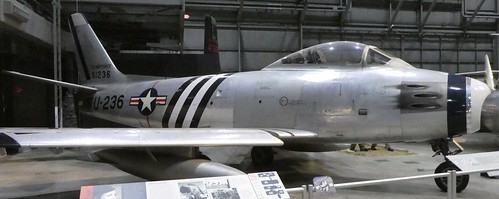
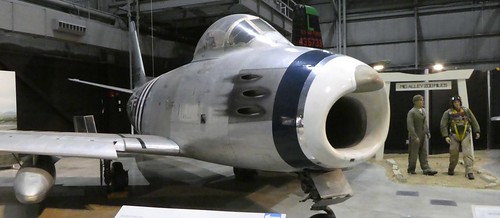

Republic F-84E Thunderjet
According to the Museum:
The rugged F-84 Thunderjet gained its greatest renown during the Korean War. Initially sent to escort B-29s on long-range missions over North Korea, the Thunderjet excelled as a close air support and daytime interdiction strike aircraft. In Korea, F-84 pilots attacked enemy railroads, dams, bridges, supply depots and troop concentrations with bombs, rockets and napalm.
The Thunderjet became the Army Air Forces' second jet fighter to enter large-scale production, and it first flew flight in February 1946. Early F-84s had several problems, including weak wing spars, excessive weight and shortages of engines and spare parts. The F-84E, however, corrected most of the Thunderjet's shortcomings.
During its service life, the Thunderjet served in several roles, including day fighter, long-range escort fighter, fighter-bomber and as the USAF's first tactical nuclear bomber. The USAF also supplied F-84s to 14 other countries.
This plane has a maximum speed of 620 mph, a range of 1,485 miles, and a ceiling of 43,240 feet.
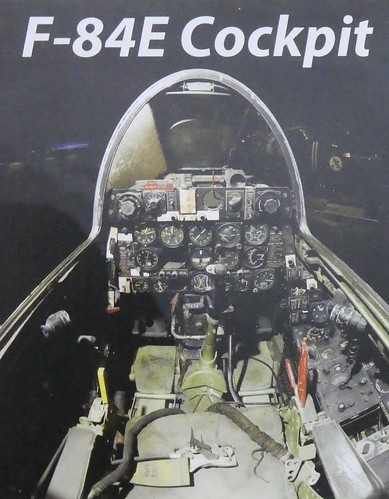

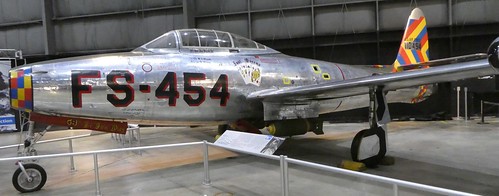
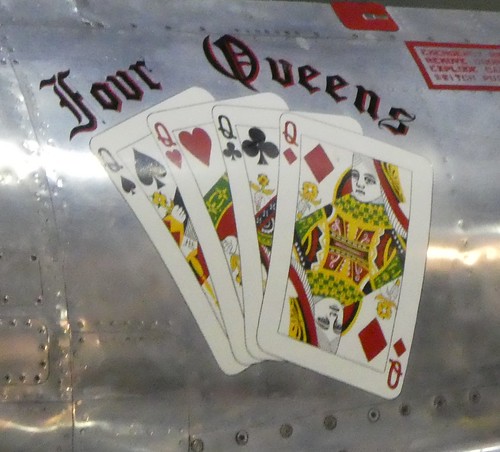
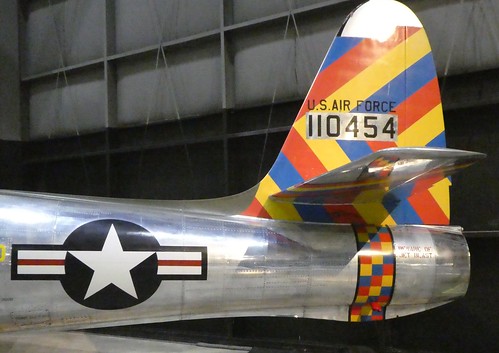

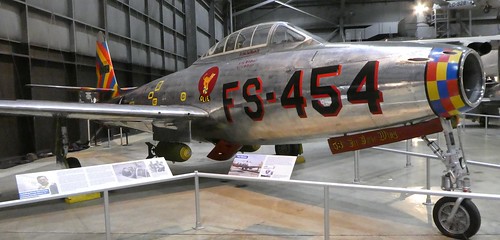
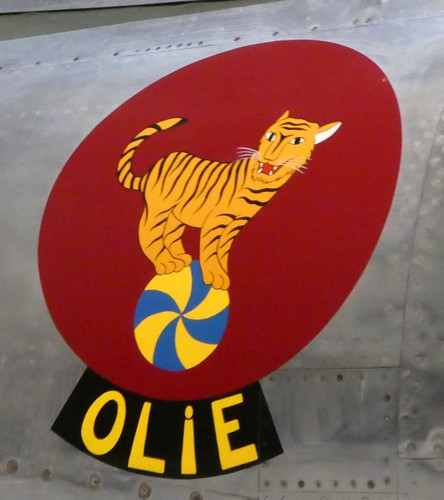
North American F-82G Twin Mustang
According to the Museum:
During the Korean War, Japan-based F-82Gs were among the first U.S. Air Force aircraft to operate over Korea. On June 27, 1950, all-weather F-82Gs shot down the first three North Korean aircraft destroyed by U.S. forces.
The F-82 was the last propeller-driven fighter acquired in quantity by the USAF. It appears to be two P-51 Mustang fuselages on one wing, but in reality, it was a totally new design. The Twin Mustang carried a pilot and co-pilot/navigator to reduce fatigue on long-range bomber escort missions. Production deliveries did not begin until early 1946, too late for World War II. After WWII, Air Defense Command flew radar-equipped F-82Gs as replacements for the P-61 night fighter.
This plane has a maximum speed of 400 mph, and a range of 2,240 miles.

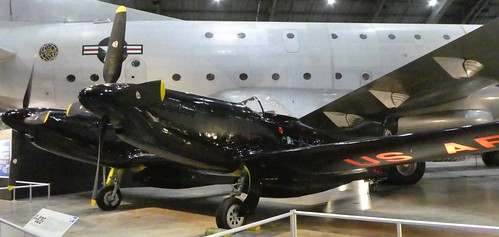





Lockheed F-80C Shooting Star
According to the Museum:
The Shooting Star was the first American aircraft to exceed 500 mph in level flight, the first American jet airplane manufactured in large quantities and the first U.S. Air Force jet used in combat.
Designed in 1943, the XP-80 made its maiden flight on Jan. 8, 1944. (The aircraft was redesignated F-80 in 1948 when "P" for "Pursuit" was changed to "F" for "Fighter.") Four YP-80s were sent to Europe for service tests, but World War II ended before the aircraft saw combat.
Although designed as a high-altitude interceptor, the F-80C was flown as a day fighter, fighter-bomber and photo reconnaissance aircraft during the Korean War. On Nov. 8, 1950, an F-80C flown by 1st Lt. Russell J. Brown shot down a Russian-built MiG-15 in the world's first all-jet fighter air battle.
This plane has a maximum speed of 580 mph, a range of 1,090 miles, and a ceiling of 46,800 feet.


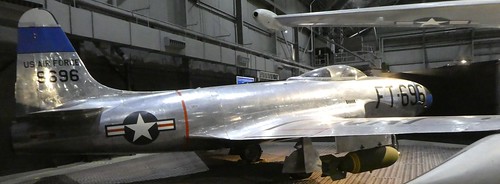

Lockheed F-94A Starfire
According to the Museum:
Developed from the T-33 Shooting Star, the two-place F-94 was the first American all-weather jet interceptor and the first U.S. production jet to have an afterburner. The large radar in the nose permitted the observer in the rear seat to locate an enemy aircraft at night or in poor weather. The pilot then flew the Starfire into proper position for an attack based upon the observer's radar indications.
During its service in the 1950s, the F-94 operated primarily in the defense of the United States against Soviet bomber attack, flying with USAF and Air National Guard units. During the Korean War, the USAF replaced the propeller-driven F-82 Twin Mustang with the more capable Starfire. In 1951 F-94s started flying in defense of Japanese air space, and the next year Starfires began flying night bomber escort and air defense missions from bases in Korea.
This aircraft has a top speed of 630 mph, a range of 930 miles, and a ceiling of 42,750 feet.
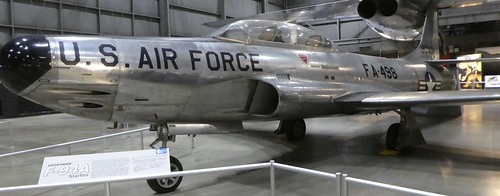
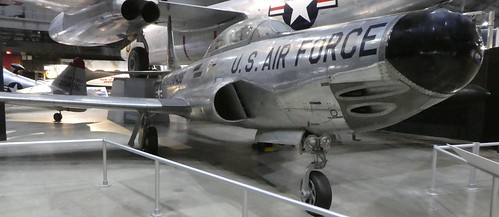


More airplanes
Air Force Museum: Sabrejets (photo diary)
Air Force Museum: MiGs (photo diary)
Air Force Museum: The Valkyrie (photo diary)
Air Force Museum: World War II German Planes (photo diary)
Air Force Museum: World War II Japanese planes (photo diary)
Air Force Museum: World War II American fighters (photo diary)
Air Force Museum: Southeast Asia air support aircraft (photo diary)
Air Force Museum: Cold War bombers (photo diary)


